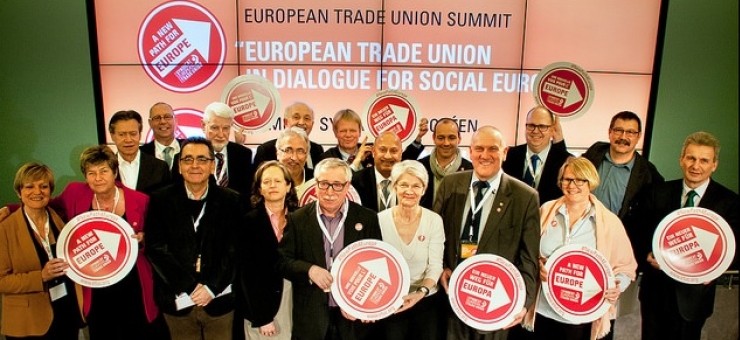EU policies 2009-2014: In search of cheap labour and in search of cheap rules

In his speech at the ETUC’s trade union summit Sam Hägglund, EFBWW General Secretary, elaborated this theme as the representative of European Trade Union Federations.
EU policies 2009-2014: In search of cheap labour and in search of cheap rules
TU Summit 19 March 2014
The last 4 years have been trying for us trade unionists that have had a positive approach to European integration. One could easily get the impression that the decision-makers in the EU are doing all they can to undermine the confidence of the European citizens in the European project. Two general trends can be identified in EU policies the last 4 years, both of them connected to the economic crisis, but mostly governed by neoliberal ideas about economic performance. The irony of these policies is that they will not only undermine the social foundations of Europe but also undermine the competitiveness of the European economy. The first trend I would like to call In Search of cheap labour, and the second one In search of cheap rules.
There are different ways of reducing labour costs, but what I will be concentrating on here is how cross-border workers and circumvention of rules can be used to press down wages. There has always been social dumping in Europe, meaning an undercutting of local and national levels of working conditions by way of foreign labour. This was also foreseen in the early days of European integration. This was why the Council of Europe in 1957 adopted the Rome Convention on Migrant workers stating that the law where one works applies. From this the principles of non-discrimination and equal treatment on the basis of host country principles evolved.
Everything worked rather smoothly for 30 years and it was generally considered that the Treaty guaranteeing equal treatment for foreign workers with national workers also applies to posted workers. In the 1990s the issue became controversial and the Posting of Workers Directive – stipulating host country rules to core conditions as a minimum – could finally be adopted in 1996 after the accession of Austria, Sweden and Finland as new EU members. The Posting Directive worked well until December 2007 when the Laval judgment came. The same week came the Viking judgment and then in 2008 the Ruffert and Luxembourg judgments.
The bad thing now was not only that equal treatment was no longer guaranteed, but that in fact equal treatment was forbidden, when it concerned posted workers. As part and parcel of this the EU restricted collective bargaining and the right to strike for posted workers’ conditions. The legislations of Member States had to change accordingly. That was the first nail in the coffin for Social Europe.
This opened up for recruiting foreign workers on low conditions and creating a race to the bottom for wages and working conditions. During the last 10 years, posting has become a means of pressing labour costs in Europe. More than 1 million construction workers are posted yearly around Europe, many of these on sub-national standard conditions. And the practices are spreading to other sectors: the meat sector, the tourism sector, the land transport sector. The use of cross-border workers was transformed into a major tool to dismantle workers’ rights and to cut labour costs around Europe.
And even worse was to come. To be able to be re-elected at last election, Barroso promised to “solve” the posting problem. He promised, but what came out of this: the Monti Regulation and the Enforcement Directive. The Monti Regulation would in fact have cemented the supremacy of the 4 freedoms over fundamental rights. Luckily, the Monti was scrapped due to the resistance from Member States. Now we have the Enforcement directive on the table, announced originally as a tool to better enforce the Posting directive, guaranteeing basic working conditions for posted workers. Yesterday, the Employment Committee of the European Parliament adopted the trialogue agreement. And what does it say? Well, the Directive is indeed about checks and controls, but checks and controls of the Member States so that they will not enforce “too much”. And it opens up for fraudulent employers to create country-of-origin situations in posting, so that the minimum conditions in a low-cost Member States would apply also in the host state. This is where we are today; the EU has gone from equal treatment of foreign workers to minimum rights for posted workers to the opening up for circumvention of all rules. The bad news is first that workers are being exploited, second, that there is no longer competition on equal terms and, and third, that Member States are losing tax revenue.
And what will be the long-term effects for the EU of this business model of low-cost labour? Well, definitely not a more efficient and competitive Europe. If we take the construction sector as an example, this has in fact also been proven by the European Commission. They made a survey where the cost of labour was compared to the project cost in the EU Member States. The result was surprising – for some. It showed that the cost of labour in the long run was inversely proportional to the project costs: cheap labour made the industry less efficient and competitive. This is well-known if we look at economic history, but sadly forgotten today in an EU in search of cheap labour.
When we want rules and enforcement mechanisms to guarantee equal treatment, we are being criticized that the EU cannot “afford” that. But what is the reality? If we just take European countries as examples, and if we use the internationally recognized indexes for competitiveness of a country and the equality situation in a country, we once again find the opposite correlation that would be expected if the neoliberal lobby had been correct: the most equal countries in Europe are in fact the most competitive ones. Social progress comes with economic progress, and they are not contradictory to one another.
The second trend I mentioned – “In search of cheap rules” – has been justified in different ways by the EU, but common to these justifications is the assumption that rules are expensive. The REFIT agenda is inspired by Cameron’s “Cut red tape” agenda, and I think we are all against red tape, unnecessary bureaucracy. But when regulations for health and safety and workers’ protection are considered to be red tape, the EU has entered a dangerous path.
When the Commission prepared the REFIT Communication, Business Europe, not surprisingly, identified labour protective directives as “harmful” and costly. This is also the basic assumption behind the REFIT agenda. The whole EU social acquis since 1990 is now in the melting-pot, to be tried in order to be proven necessary. And all future EU social initiatives have to be tested against the REFIT criteria, even the ones proposed jointly by the European Social partners. Business Europe is basically an ideological organization, but the sectoral employers’ organizations are often less ideological. They realize the costs and burdens of having un-healthy working conditions for their workers. When UNI Europa negotiated and agreed with Coiffure EU on the hairdressers’ agreement, it wasn’t about introducing new red tape. It was about protecting the health and safety of one of the most dangerous professions.
And the answer from the Commission was making fun of the agreement. By refusing to forward this agreement to make it legally binding, the Commission basically winded the clock back to before the Maastricht Treaty of 1993. This was done in spite of estimations from both social partners that the benefits of the agreement far outweigh the costs of implementing it. But to no avail.
But the de-regulation agenda is not only justified by the REFIT agenda. When now more and more details are revealed about the EU trade agreements, we clearly can include them in the list of justifications for de-regulations. The CETA negotiations with Canada are announced to be over, but obviously are still not. The Investor-state dispute settlement is a hot potato and will continue to be. Will the possibility for EU states to retain their regulations be negotiated under the auspices of international arbitral tribunals? The CETA agreement – and now also the TTIP – introduces a so called “negative list” in making liberalization commitments. This is the opposite of what the EU has done until now. The negative list means that all that is not excluded is covered, which makes it harder for public authorities to take account of new and changing needs.
The trade agreements are basic justifications for de-regulations. But in a democratic society, companies should not have the rights to challenge decisions by governments. Because of the NAFTA agreement, Canada have had to pay millions of dollars to companies for deciding to ban toxic waste and for banning carcinogenic substances, and for taking back water and timber rights of a company that walked away from its obligations in Newfoundland. And in Europe, Sweden’s state-owned energy company Vattenfall is taking Germany to the International Centre for Settlement of Investment Disputes for the closure of its nuclear power plants.
The trade agreements are basically not about reducing tariffs, it is about de-regulation. The trade agreements risk to limit the possibility for governments, societies and the EU to regulate its markets, in order to protect its citizens. The protection regulations, the health and safety rules, the banning of carcinogenic substances; they are not costly “red tape”; they are there to secure the well-being of its citizens.
It is a dangerous path the EU has embarked upon with its two-fold agenda: in search of cheap labour and in search of cheap rules. It is a path that is socially unjustifiable, but it is also economically unjustifiable and will make Europe poorer. EU should compete with skills and innovations, not with cheap labour and “cheap rules”.

